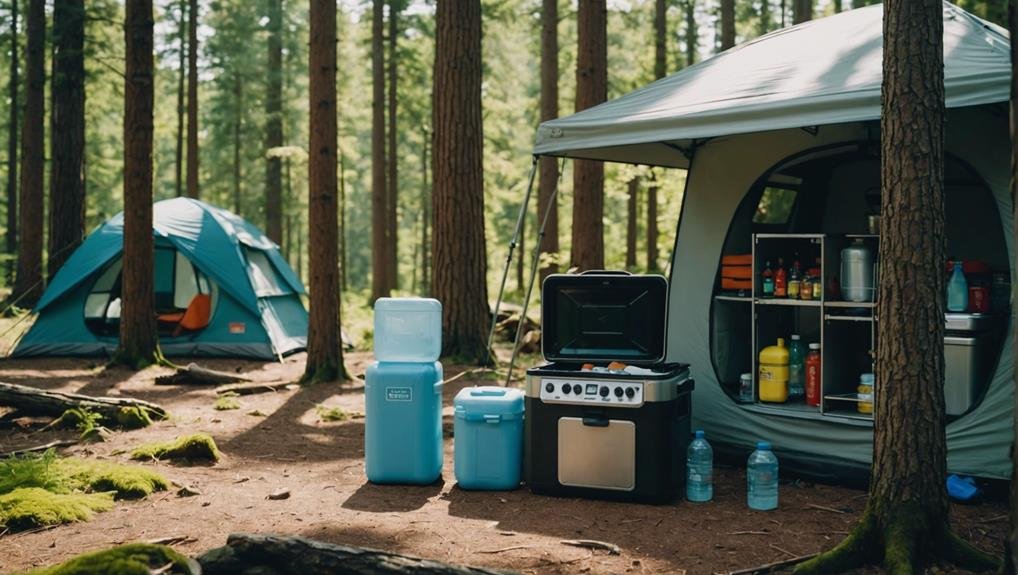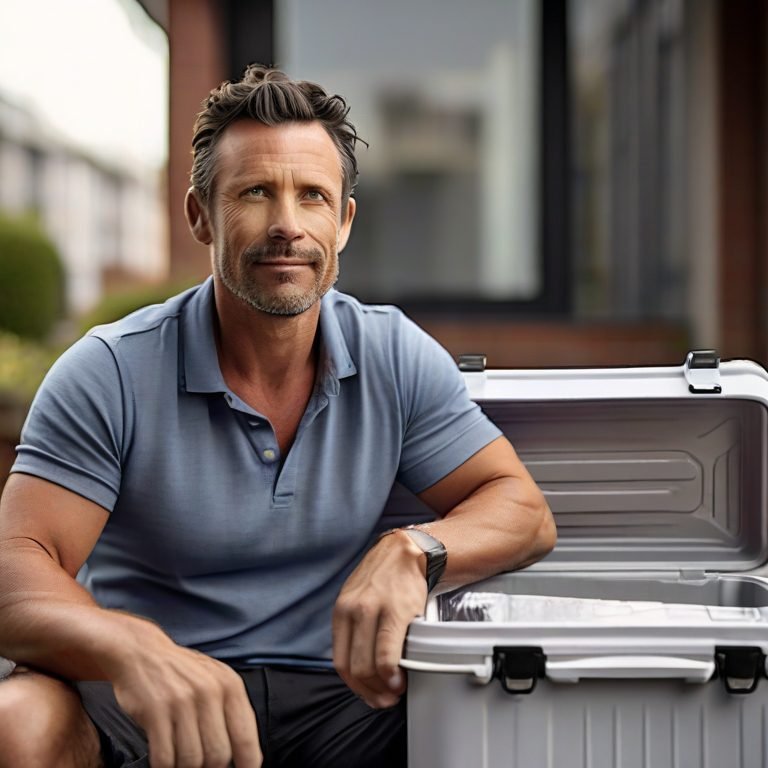When you’re planning your next camping trip, consider how essential it is to keep your food cold, not just for safety but also for your enjoyment. You’ll want to start by choosing a high-quality cooler, such as one with superior insulation capabilities.
But selecting the right cooler is just the beginning. How you pack and manage your cooler can notably impact its effectiveness. For example, did you know that pre-chilling your cooler or organizing its contents could help maintain the desired temperature? Let’s explore some effective strategies that might surprise you and keep your perishables fresh longer.
Key Takeaways
- Pre-chill your cooler and use block ice for longer-lasting cold retention.
- Freeze food items before packing to use as additional ice packs.
- Limit the frequency of cooler openings and organize contents for quick access.
- Place your cooler in a shaded area or cover it to protect it from direct sunlight.
- Utilize insulating materials like wet towels or foam pads to enhance cooling efficiency.
Select a High-Quality Cooler
Investing in a high-quality cooler, like a YETI with its thick insulated walls, guarantees your food stays cold throughout your camping trip. You’ll want to focus on coolers famed for their ice retention capabilities, ensuring that your provisions remain chilled and fresh, whatever the weather outside.
The secret lies in the design of these coolers, particularly their robust insulation and sealed lids, which prevent warm air from infiltrating and cold air from escaping. This superior refrigeration keeps your food storage safe and fresh. When choosing a cooler, opt for a hard-sided rather than a soft-sided one.
Hard-sided models offer superior protection against the elements and the rough and tumble of outdoor life. They’re built tough, and their durability pays off in the long run. The dense material withstands frequent use and contributes significantly to the insulation properties, enhancing the cooler’s ability to keep ice from melting.
Also, consider the size of your cooler carefully. If you’re planning a lengthy camping trip, you’ll need a larger capacity to store all your perishables, snacks, and cold water bottles. This ensures you won’t run out of space or ice too quickly, keeping your meals, supplies, and other camping gear safe and cold as you enjoy the great outdoors.
Additionally, portable coolers with efficient refrigeration are essential for campers who want to keep their food and drinks cold during hikes and campfire gatherings. The right cooler will store all necessary supplies, including water bottles, food, and snacks, ensuring you have everything for a successful and enjoyable camping trip.
The results of investing in quality camping gear, like a robust cooler, speak for themselves. They provide reliable food storage and refrigeration throughout your adventure.
Pre-Chill Your Cooler
Before you pack your perishables, it’s important to pre-chill your cooler with ice or frozen gel packs to make sure it maintains a lower internal temperature. This step is vital for enhancing your cooler’s cooling efficiency. By cooling the interior before adding your food, you’re setting the stage for a prime cold environment that lasts.
Pre-chilling isn’t just tossing a few ice packs in; it’s about giving your cooler a few hours to stabilize at a cooler temperature. This preparation ensures that when you finally pack your perishable items, they’re placed in a cold environment rather than relying solely on them to cool the space. It’s a proactive approach to food safety, preventing food from spoiling quickly under less ideal conditions.
Organize Cooler Contents
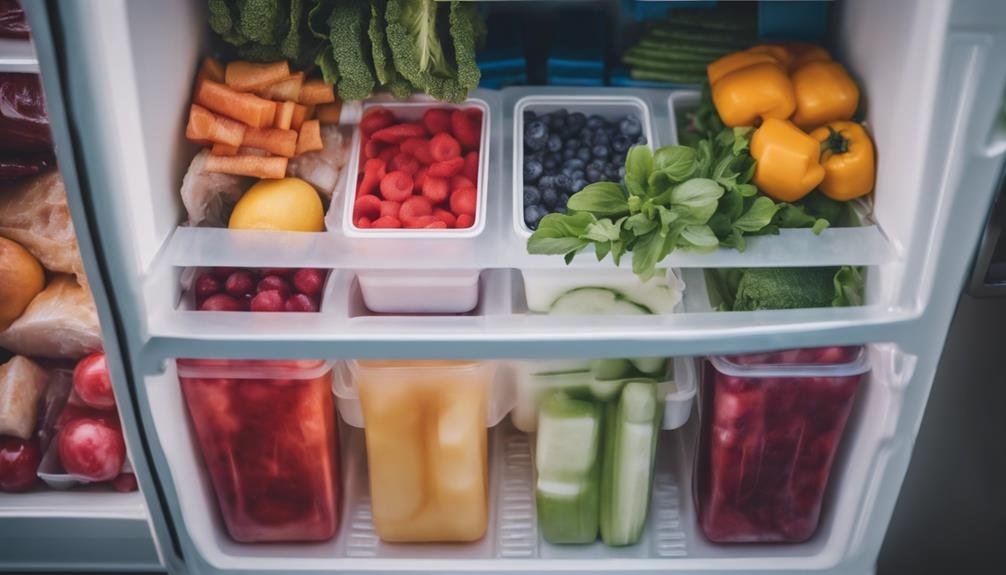
To maintain your cooler’s efficiency and safeguard food safety, strategically organize its contents by placing frequently accessed items at the top and raw meats at the bottom.
This setup helps reduce the risk of spreading harmful bacteria and keeps your cooler organized so you can find everything quickly without letting cold air escape too often.
Here are a few tips to help you organize your cooler more effectively:
- Utilize Containers and Bags: Place different types of food in separate containers or resealable bags. This helps to keep food fresh, prevent cross-contamination, and allows for better insulation within the cooler.
- Strategic Placement: Besides placing frequently used items on top and raw meats at the bottom, store perishables like dairy and eggs near the middle, where they are colder. This organization aids in maintaining consistent temperatures throughout your cooler.
- Cooler Placement: Always keep your cooler in the shade. Direct sunlight can heat the exterior and reduce the cooler’s overall effectiveness. A shaded spot provides natural insulation, helping keep food cold for longer.
Freeze Food Beforehand
After organizing your cooler, consider freezing your food beforehand to enhance its longevity and safety further. Freezing food extends its freshness and greatly lowers the risk of spoilage while camping. This proactive step means you’ll worry less about your meals and more about enjoying the great outdoors.
Frozen food acts as additional ice packs, maintaining a colder temperature inside your cooler. This is particularly helpful if you plan a longer camping trip or a warmer climate. Turning your meals into ice packs kills two birds with one stone, keeping your cooler cold while packing your nourishment.
Moreover, preparing and freezing meals in advance simplifies the packing process. You’ll find it easier to organize and fit everything into your cooler. Use properly sealed containers to prevent food contamination and guarantee everything is safe. These containers also make it effortless to stack and arrange food items, maximizing space and minimizing mess.
Use Block Ice

When packing for a longer camping trip, consider using block ice to guarantee your food stays cold and safe. Unlike regular ice cubes, block ice has a larger size and a slower melting rate, making it perfect for extended adventures in the great outdoors. Here’s why you should opt for block ice on your next trip:
- Longevity: Block ice lasts a considerably longer time than ice cubes. Its slow melting rate means you won’t have to worry about refilling your cooler frequently, saving you time and effort.
- Efficiency: It maintains a colder temperature inside your cooler. This consistent chill ensures your perishables stay fresh and safe from spoilage throughout your trip.
- Cleanliness: Block ice melts slower, reducing the risk of your food sitting in a pool of water. This keeps your items dry and delicious and makes clean-up less hassle.
Choosing block ice is a strategic move to enhance your camping experience. It’s about enjoying your time outdoors without the constant concern over food safety. So, pack your cooler with block ice and rest easy, knowing your provisions are well taken care of.
Limit Cooler Openings
Limiting how often you open your cooler is key to keeping your food cold and fresh while camping. Warm air rushes in every time you lift that lid, and the cold escapes, forcing the ice inside to melt much quicker. This reduces the ice’s lifespan and compromises the freshness of your food. You’re out to enjoy your camping trip, not to worry about spoiled meals!
To keep everything cold, organize your cooler to quickly grab what you need without digging through piles of food. Maybe keep all your beverages in one cooler and perishables in another. This way, you won’t have to open the food cooler whenever someone needs a drink. Also, try to decide what you want from the cooler before you open it, minimizing the time the lid stays open.
Shade Your Cooler
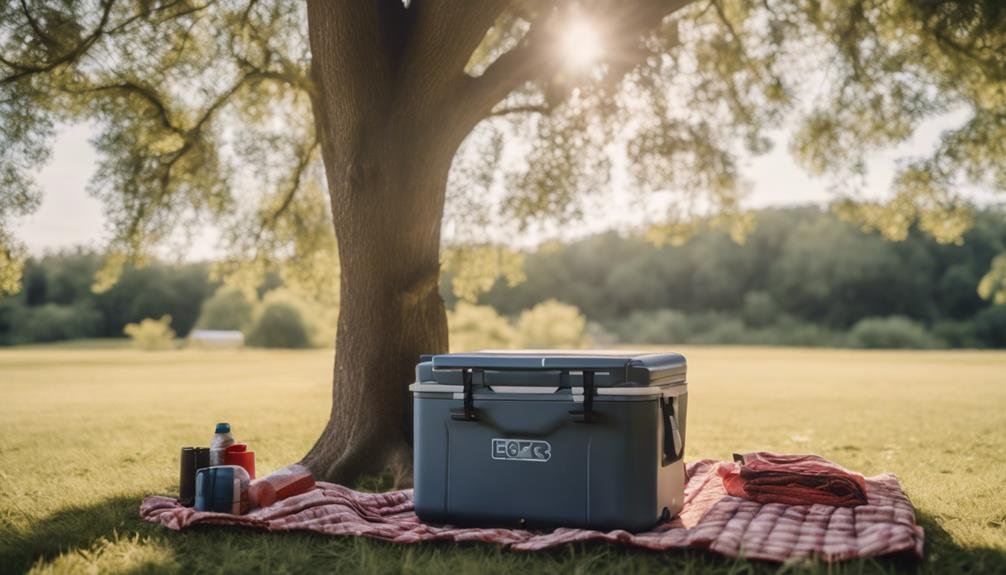
To guarantee your cooler stays colder longer, place it in a shaded area away from direct sunlight. The sun’s intense rays can rapidly increase the internal temperature of your cooler, causing the ice to melt sooner and your food to spoil faster. Selecting a shaded spot will help cold air stay trapped inside, maintain a lower temperature, and ensure your items stay cold throughout your camping trip. Here are some effective ways to keep your cooler in a shaded spot:
- Natural Shade: Look for natural shade under trees or rock formations. These areas are cooler and protect the cooler from direct sunlight throughout the day.
- Artificial Shade: If natural shade isn’t available, create your shade. Use a reflective tarp or a specially designed-cooler cover. These materials reflect sunlight and prevent heat from penetrating your cooler, keeping the contents cold.
- Strategic Placement: Even in shaded areas, the sun’s position changes throughout the day. Place your cooler in a spot where it will remain shaded as the sun moves, such as on the north side of a large object or structure.
Utilize Natural Cooling
Beyond guaranteeing shade, you can also harness natural elements to enhance your cooler’s efficiency. One effective method is to utilize natural cooling by burying your cooler partially in the ground. Cooler soil temperatures will help keep the cooler’s contents chilled for longer. Additionally, consider placing a wet towel over your cooler.
The evaporation from the damp towel will draw heat away from the cooler, further aiding in maintaining low temperatures inside. To optimize this setup, position your cooler in a breezy location. The airflow will speed up the evaporation process from the wet towel and carry away the heat, keeping the cooler environment much fresher.
This tactic is particularly helpful during the hotter parts of the day when the sun is at its peak. Lastly, don’t overlook the value of insulating materials. Wrapping your cooler in blankets or foam pads can greatly boost the insulation, making all the other natural cooling techniques you’ve employed even more effective.
Combining these strategies will ensure your provisions remain fresh throughout your camping adventure without relying solely on manufactured ice packs or electronic cooling devices.
Pack Cooler Efficiently
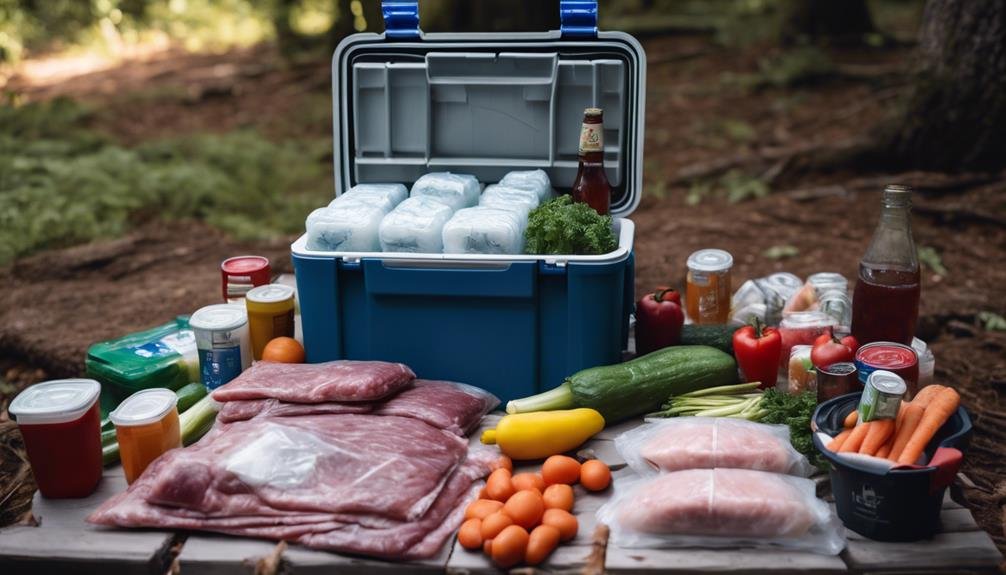
Efficiently packing your cooler maximizes space and enhances the longevity of your stored food. Here’s how you can optimize your cooler setup to make sure you’re keeping your food chilled throughout your camping trip:
- Use Frozen Goods Strategically: Pre-freeze meats, dairy products, and some fruits as makeshift ice packs. These frozen items help maintain the cooler’s internal temperature, acting as additional cooling agents. Place these frozen items strategically around the cooler to spread the chill evenly.
- Place Items Properly: Always place your raw meats and other perishables at the bottom of the cooler. This setup prevents juices from contaminating other food items in case of leakage. It also capitalizes on the fact that cold air sinks, keeping these items in the coldest part of the cooler.
- Organize for Accessibility: Store items you’ll need frequently at the top of the cooler. This arrangement minimizes the cooler’s open time and helps maintain the cold environment inside. Use separate containers or resealable bags to keep everything organized and easy to grab.
Conclusion
You’re all set to keep your food cold on your next camping trip! Remember to pick a high-quality cooler like a YETI, pre-chill it for maximum efficiency, and organize everything smartly. Freezing your food and using block ice will extend its coolness. Open your cooler as little as possible, keep it shaded, and use natural cooling methods. Packing it efficiently is key. Follow these tips, and you’ll enjoy fresh, safe food throughout your adventure!
FAQs
What are the best methods to keep food cold during a picnic?
The best methods include using insulated coolers with ice packs, pre-chilling the food, and keeping the cooler in a shaded area. Consider wrapping food in aluminum foil for extra insulation.
How long can food stay cold in a cooler?
Food can typically stay cold in a cooler for about 24-48 hours if properly packed with sufficient ice or ice packs. Regularly checking and replenishing ice will help maintain the temperature.
Who can recommend portable coolers suitable for camping trips?
When it comes to finding portable coolers suitable for camping trips, a few trusted sources can provide valuable recommendations. One of the top authorities in this field is the International Camping and Outdoor Equipment Association (ICOEA).
ICOEA conducts extensive research and testing on various portable coolers available in the market, considering insulation efficiency, durability, and portability. Their team of experts thoroughly evaluates each cooler’s performance under different camping conditions. Additionally, ICOEA collaborates with renowned outdoor enthusiasts and camping experts to gather their insights and feedback.
Can dry ice be used to keep food cold?
Yes, dry ice can keep food cold for longer periods. However, it must be handled carefully and used in a well-ventilated space. Dry ice is especially effective for freezing food.
What are effective methods to keep meat cold while camping?
When it comes to keeping meat cold while camping, several effective methods ensure its freshness and prevent spoilage, one tried-and-true method is to use a portable refrigeration system specifically designed for outdoor use.
These innovative devices utilize advanced cooling technology powered by solar energy, allowing you to maintain a consistently low temperature for your meat throughout your camping trip.
Another option is to use dry ice, which can be placed in a well-insulated cooler along with the meat. Dry ice has an extremely low temperature and can keep your meat frozen for an extended period. Additionally, packing your meat in vacuum-sealed bags before placing it in the cooler will help preserve its freshness and prevent cross-contamination.
What are the best ice packs to use for keeping food cold?
Reusable gel packs, hard-sided ice packs, and DIY ice packs made from frozen water bottles are all effective options. They provide long-lasting cold without the mess of melting ice.
How do I keep food cold in a cooler without ice?
Use frozen gel packs or frozen water bottles as alternatives to ice. Pre-chill the cooler and food, and insulate the cooler with towels or blankets to maintain low temperatures for longer.
How long does ice last in a cooler?
Ice can typically last in a cooler for about 2-3 days, depending on various factors such as the quality of the cooler, outside temperature, and how often the cooler is opened. However, to maximize the lifespan of ice in a cooler, you can follow a few tips.
Firstly, ensure your cooler is pre-chilled before adding ice by storing it in a cold place or filling it with ice for a few hours before use. Additionally, using block ice instead of crushed ice can help prolong its longevity. Another useful tip is to minimize opening the cooler as much as possible to prevent warm air from entering and melting the ice faster.
Recommended Articles:
Igloo Picnic Cooler for Outdoor Bliss: Stay Fresh, Stay Cool
The Ultimate Beach Cooler Backpack: Cool Waves Companion
What Are the Best Coolers for Outdoor Picnics?

